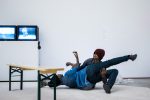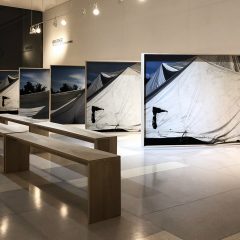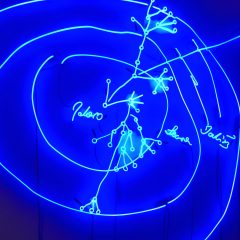Post by Mari Shaw
This is part 2 of Mari Shaw‘s post about Berlin Gallery Weekend.
Read Part 1. Parts 3 and 4 will follow.
A must- see Gallery Weekend show is a large installation by Andreas Siekman that inaugurates Galerie Barbara Weiss’s new ground floor space on Zimmerstrasse.
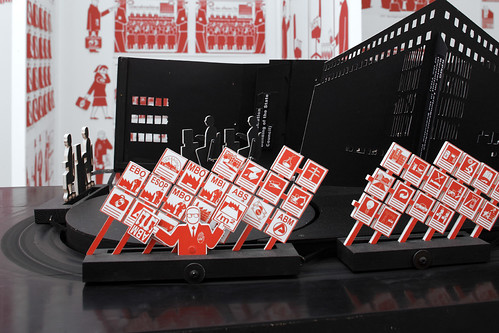
Siekman is a brilliant, gifted artist who, along with his talented artist wife Alice Creischer, has been an important and active voice in Germany’s left-leaning intelligentsia since the 1970s. After completing their studies at the famed Düsseldorf Academy, Siekman and Creischer moved to Berlin. Each of them founded much- heralded underground art magazines, engaged in spirited discussions about the nature of art and society with whoever was interested, and began 30 years of jointly creating highly political, community-based art projects all over the world. Siekman particularly has been a mainstay of important, public art exhibitions — like the Venice Biennale, two Documentas, two Muenster Sculpture Shows. He is so strong intellectually that curators in Germany often solicit his view when they are conceptualizing public exhibitions. He is the real thing.
Siekman’s work at Galerie Barbara Weiss, Negotiations Under Time Pressure, examines the economics of the reunification of East and West Germany after the Berlin Wall came down. Siekman’s installation depicts the financial institution-led transformation of 13,800 East German nationally owned enterprises into incorporated firms in less than four years– at the rate of 15 per day. Siekman questions: at what price to the public and the urban landscape was this “miracle” of economic transformation, an economic model that has since been adopted in many places in the world?

Andreas Siekman, detail, Negotiations Under Time Pressure, at Galerie Barbara Weiss. Photo courtesy of the gallery.
Siekman covered the gallery walls with black and red, pop-looking computer generated drawings using the pictogram language of the 1920s.
In the center of the main gallery space, Seikman, with the help of an expert craftsman, built a Theatrum Mundi, Stations of a Mechanical Mechanism. Small wooden buildings of the financial institutions are in the center of a large table. A small conveyor belt circles around the building sculptures carrying fanciful miniature sculptures of the prominent banking and political players, the figures of liquidation. The Theatrum Mundi is reminiscent of an elaborate toy train display, complete with mountains and scenery and figures, that a bourgeois family might install near an ornament-laden Christmas tree.
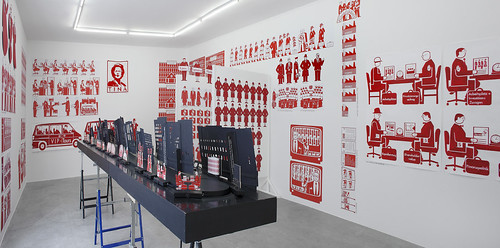
Andreas Siekman, detail, Negotiations Under Time Pressure, at Galerie Barbara Weiss. Photo courtesy of the gallery.
To depict the transformed urban landscape, Siekman uses the art of Disneyland. His art seduces with perfectly crafted miniature people going round and round and black and red graphics to please our eyes and dull our senses, just as the market drivers gussy up our old Cities with eye-catching, high-rise glass malls for paying customers. Then the drug wears off and you see what the transformation has meant with your brain, the real locus of sight.
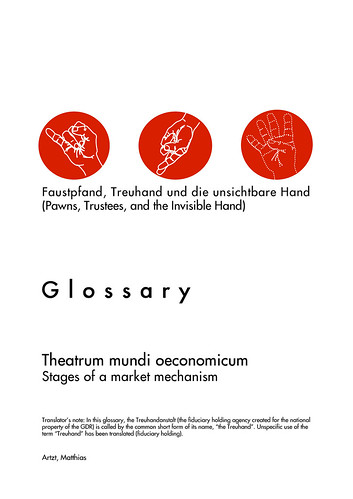
Andreas Siekman, detail, Glossary for Negotiations Under Time Pressure, at Galerie Barbara Weiss. Courtesy of the gallery. Read the Glossary here.
When I went to Potsdamer Platz to see a movie a week after I saw Siekman’s exhibition, I noticed the remaining remnant of an old German landmark building that had been sacrificed for the modern construction. The old wall was enclosed in glass as an architectural embellishment in the entertainment center/shopping mall/business development Potsdamer platz has become. It brought me right back to the Siekman exhibition.
I own work by Andreas Siekman–some drawings that were part of a series in his first Documenta show. I wish I had more. At one point, Peter and I went back to buy a beautiful multiple drawing work of his that we both loved, but a museum snapped it up before we had returned to make our purchase. I have had wonderful, free ranging conversations with Andreas and Alice around their kitchen table. I also interviewed them for a writing project that never came to fruition. They are both straight-forward, intelligent, right minded, honest through and through people whom I greatly respect. Andreas is an unbelievable character… so good hearted with boundless energy and a zig-zagging mind. Alice is steady and stable and a warm mother earth. I like them very, very much.
While you are at Galerie Barbara Weiss, peek upstairs into Barbara Weiss’ original gallery space. There hang samplings of other artists Weiss represents, including Thomas Bayrle, a fallen away Marxist who since the 1960s has been making remarkable hand drawn pop prints reflecting his political thinking. The Bayrle prints Barbara Weiss has hanging are beauties. I also own a Thomas Baryle print. I have been seated next to Thomas at dinner a couple of times. He is charming and amazingly youthful and open (He is 70).
Link to part 1 of this post.
Link to part 2 of this post.
Link to part 3 of this post.
Link to part 4 of this post.
–Philadelphia collector and international traveler Mari Shaw last reported for us on ARCO, the Madrid art fairs. Shaw and her husband Peter spend several months each year in Berlin.


